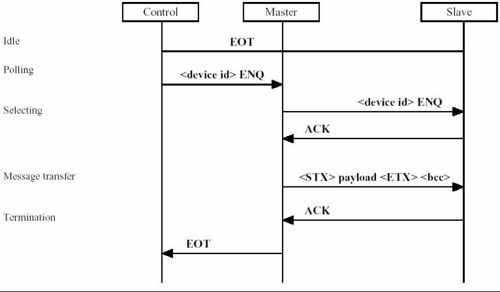ISO Data Link Layer
From Zenitel Wiki
The protocol is based on the ISO 1745 standard using the ISO 1155 longitudinal parity. The protocol can be used with RS232 and RS422 pointtopoint connection, but also with RS485 multidrop bus connection.
The ISO Data Link layer procedure is based on the ISO1745 standard: Information processing Basic mode control procedures for data communication systems. The standard includes the concept of having a Control Device, Master Device and Slave Device.
The Control Device polls the devices, one at a time in an orderly fashion, inviting them to transmit messages. The devices that transmits a message becomes the Master Device. This device selects the destination device, which becomes the Slave Device, inviting it to receive an information message. The Master Device sends the message and the Slave Device acknowledges the message.
The AlphaCom module is always the Control Device.
Contents
Overview
A complete message transmission sequence progress as follows:
<br\> <br\> <br\> <br\><br\><br\><br\><br\><br\><br\><br\><br\><br\><br\><br\><br\><br\>
Transmission Control Characters used
The following control characters are used in the protocol:
The first 32 characters, ASCII 0 31 (0x00 0x1F) is not allowed in the payload of an message.
Note that the message’s Block Check Character can have any value, including the reserved transmission control characters!
STX - Start of text
STX is a transmission control character which precedes a text and which is used to terminate a heading. STX is transmitted by the Master Device.
ETX - End of text
ETX is a transmission control character which terminates a text. ETX is only transmitted by the Master Device and calls for a reply from the Slave Device. ETX is followed by a BCC, “block check character”.


